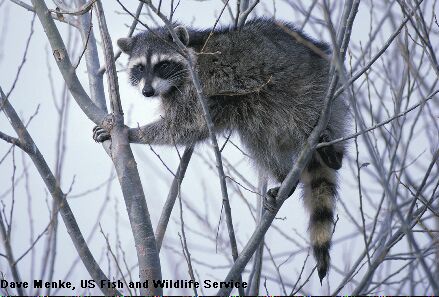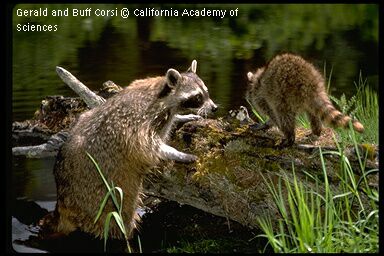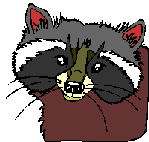Where the raccoon lives
The raccoon is found in southern Canada (Alberta, Saskatchewan,
Manitoba, Ontario, Quebec, New Brunswick and Nova Scotia).
It spends much of its time in trees or near streams or lakes
searching for food.
The raccoon will live in a hollow tree, in a cave and even under a building.

photo: Dave Menke, US Fish and Wildlife Service
Appearance
The raccon has black fur that grows around its eyes.
It looks like it is wearing a mask.
Most of the raccoon's coat is a grizzly grey.
The fur on the tail is light in colour with black rings.
There may be four to six rings on its bushy tail.
The raccoon is the size of a small dog.
It is a cousin of the bear.
Food
The raccoon looks for food
in the evening. It walks near streams and lakes searching
for its favourite food - crayfish. Raccoons also eat snails,
frogs, reptiles, insects, young birds, birds' eggs, corn and berries.
Raccoons can be pests. They go into yards and knock
over garbage cans looking for something to eat.
It holds food in its paws underneath the water
and rolls the food around to wash it. When it is not near water
it eats without washing its meal first.
Enemies
The raccoon is fierce so it doesn't have many enemies.
Bobcats or wolves may attack it but it can fight them off.
Adaptation
The raccoon uses its paws almost as well as you use your hands.
It walks slowly but can climb a tree quickly. It is also a very good
swimmer.
The raccoon prepares for winter by growing a thick coat.
In the winter the raccoon often sleeps but does not hibernate.
It wakes up and will go out to eat on warmer days.
Babies
The raccoon is a mammal. The female has four to six babies
in a hollow tree or log, in some rocks or in an empty burrow that
some other animal has left behind. Babies are born in May or June.
They are greyish brown when born. In a few weeks their black masks
and rings of their tails appear. In three weeks their eyes are open.
At first the mother leaves the babies in the den at night
while she go out to find food. In two months
the young can leave the den and search for food with their mother.
The young raccoons usually stay with their mother for the first winter.

Gerald and Buff Corsi � 2001 California Academy of Sciences
Interesting facts
If a raccoon is caught when it is young it can be tamed.
It can make a fine pet. But as it grows older it may become cross.
pictures and facts about raccoons
CANADIAN ANIMALS
|

